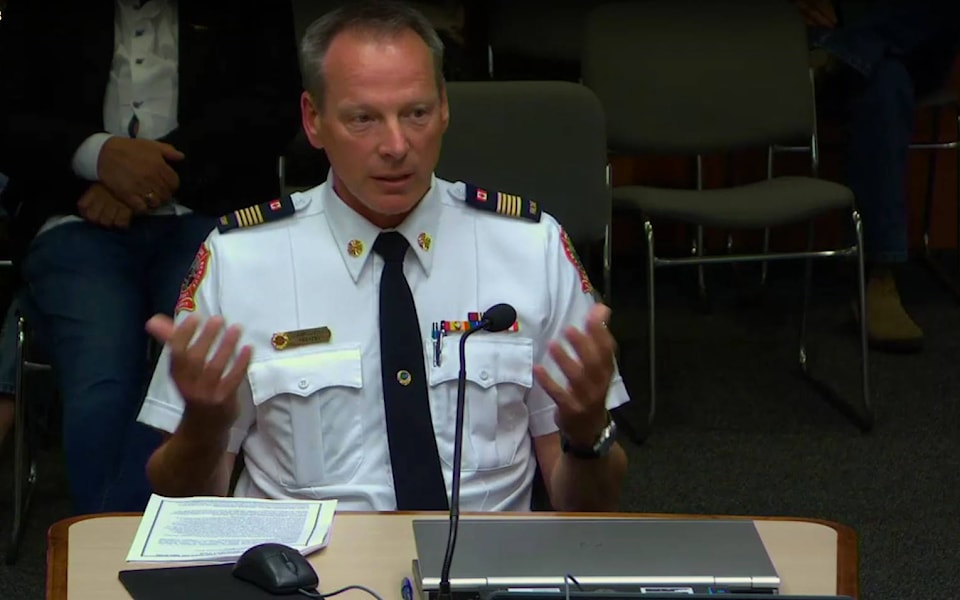First in a series of articles about how Nelson is preparing for the possibility of a wildfire in the city
Nelson’s fire chief Len MacCharles says nobody will be left behind if Nelson has to be evacuated due to a wildfire in some future smoky summer.
He addresses that assurance especially to people in the hospital, people in seniors homes, people with no car and people with mobility or health problems.
“If you don’t have a car, talk to your neighbour, friends, or family, in advance. Ask if you can go with them. If there are people with no alternative, we will be there. We won’t leave anybody behind. But to do that effectively we need the people who can take care of themselves to take care of themselves.”
MacCharles urges those people, the self-sufficient ones, to have their own personal evacuation plan that includes 72-hour emergency kit. He also wants them to get a FireSmart inspection of their home.
He said the Interior Health Authority has a good evacuation plan for the hospital and its other facilities and their staff are trained in it.
New emergency management agency
MacCharles, in addition to his fire department job, will be the head of Nelson’s new emergency management centre, and is the only staff member working on the program so far.
At its Sept. 4 meeting council passed third reading of a bylaw that will set up the Nelson Emergency Management Program.
Until now the city has relied on the emergency management capacities of the Regional District of Central Kootenay (RDCK) but, following a 2015 assessment report by MacCharles, the city decided to create its own plan, although still in co-operation with its rural neighbours.
Evacuation: managing the challenges
City council hired MacCharles as fire chief about four years ago partly because of his experience as head of Calgary Emergency Management Agency during the 2013 floods and as incident commander for many incidents including the wildfire that destroyed much of Slave Lake, Alta., in 2011.
“I have been involved in many evacuations, ranging from blocks to communities to the one in Calgary where we evacuated 80,000 people. It never goes smoothly and the more pre-planning you can do, the more organizing leading up to it, that pays huge dividends in minimizing the chaos,” MacCharles told the Star.
Even though the spectre of an evacuation due to wildfire is at the forefront of Nelson residents’ minds, MacCharles said an emergency management plan will deal with a variety of possible risks.
Preparation, mitigation, response, and recovery
His first step will be a hazard risk and vulnerability analysis.
“This is where you explore all the possible hazards that Nelson could face, from wildfire to severe weather to hazardous materials releases, then establish the likelihood and the consequence,” he said. “When you establish the likelihood and the consequence of a hazard, that equals your risk. That is the easy part.”
The harder part is creating plans for each identified risk, focusing on four components: preparation, mitigation, response, and recovery.
Preparation includes setting up systems of communication to be used when an incident is escalating, and making the public aware of them in advance.
“You need to communicate with everyone, all residents and businesses of Nelson.”
The fourth component, recovery, is a special challenge, MacCharles said.
“Governments struggle with recovery. Look at any large scale incident that has taken place. Where things fall down is during recovery. Usually it is long and drawn out, and we have already used up lots of resources and energy in the response mode. Recovery starts very early and can go on for months or years. There are still people who tear up when they talk about their experience in Fort McMurray.”
Related:
• FireSmart assessment an eye-opener for Nelson homeowner
• Develop a personal wildfire plan, Nelson fire chief says
Funding and a five-year plan
Recently the city applied for and received $172,000 from the Columbia Basin Trust and the Union of B.C. Municipalities to cover two years of setting up the emergency plan and office. MacCharles says it will take five years to set up a full emergency management program, including doing the hazard risk analyses, writing the management plan, setting up various systems in conjunction with the RDCK, and establishing the office.
Public expectations have changed
MacCharles said the public has high expectations that the city will serve them well in an emergency.
“The last few summers have woken people up, really driven home that we have things at play including climate change. The possibility of a wildfire impacting Nelson is very high, and people have expectations that the city is doing what it needs to do.”
And he said the public’s expectations of government have changed.
“Going back 15 years, the public was more accepting that the local authority would focus first on resolving emergency issues, and then look after their needs. Now, people are not as prepared to wait to have their needs met and so the local authority needs to do the best we can to meet those expectations. This bylaw is one of those ways of getting to meet more of those by more people.”
Related: Wildfire: Nelson most endangered of BC towns over 10,000, expert says
bill.metcalfe@nelsonstar.com
Like us on Facebook and follow us on Twitter
